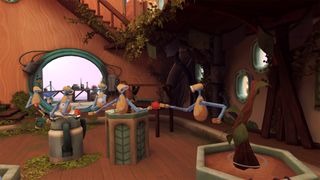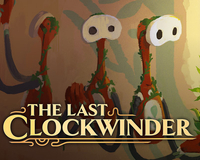Android Central Verdict
The Last Clockwinder provides a wealth of cleverly-designed puzzles that won't just challenge your brain but also keep you on your toes (literally) as you attempt to move as quickly as possible to harvest fruit efficiently. These puzzles, juxtaposed with an intriguing storyline about the mystery of the lost caretaker, make this unconventional puzzler a successful formula to follow.
Pros
- +
Intriguing storyline
- +
Puzzles are very cleverly designed
- +
Striking visuals
- +
Fun gameplay mechanics
Cons
- -
Physical puzzles could be too challenging for some players
- -
Not much environmental variety
Why you can trust Android Central
Puzzle games often revolve around moving small pieces into the right places to accomplish something larger. It's an age-old practice that both stills the mind and keeps it stimulated. It's the sort of paradox that fits nicely into the world of The Last Clockwinder, where you have to unravel a mystery of what happened to the woman who was taking care of the Clockwinder tree.
The Last Clockwinder is a narrative-heavy physical puzzle game that stretches the definition of the genre, making it feel something like a mix of games instead of a single genre-defined title. It's a bit of Firewatch, with its mysterious narrative-driven recordings and radio calls, and a bit of We Are One — formerly known as Help Yourself in SideQuest — which gave players the ability to record their actions and enshrine them in a robot that loops every few seconds.
It's a rare breed of puzzler that requires you to be both dexterous and deft, not just clever. But it's also one that might challenge players on a physical level they didn't expect from a puzzle title.
The Last Clockwinder: What I loved

If I've learned anything from games like 12 Minutes, it's that the environment around you isn't nearly as important as the mechanics and narrative that takes place within those four walls
I typically prefer single-player games over their multiplayer counterparts. Much of that love comes from my desire to follow a narrative that helps a game's mechanics make sense. In other words, I want a storybook that I can interact with, not just follow along with. In that way, The Last Clockwinder helped scratch the itch, with an interesting narrative that unfolds the deeper you delve into the Clockwinder tree.
At first, I wasn't sure about the game's setup. After all, the entirety of the experience takes place inside of a single tree (really just a single room that constantly shifts and changes). However, if I've learned anything from games like 12 Minutes, the environment around you isn't nearly as important as the mechanics and narrative that takes place within those four walls.
| Category | Header Cell - Column 1 |
|---|---|
| Title | The Last Clockwinder |
| Developer | Pontoco |
| Publisher | Cyan Ventures, Robot Teddy |
| Genre | Puzzle |
| Platforms | Meta Quest 2, SteamVR |
| Play time | 4-5 hours |
| Players | 1 |
| Launch price | $24.99 |
| Space required | 1.9GB |
The Last Clockwinder's story is beautiful in its simplicity. It's the timeless tale of two humans who had a falling out, only to later realize how much they meant to one another. Intermingled with this patchwork of recordings and memories, your character must complete tasks to pull the tree out of the waters that have overtaken it through years of neglect.
Each of these tasks takes place on a "floor" of the tree, which you can swap out on command by teleporting over to the control panel. Floors are unlocked by finding keys, which reveal new areas on the globe next to the control panel, and by harvesting fruit through the use of cleverly-designed physical puzzles.
In the most basic description, The Last Clockwinder is a sort of gardening game where the goal is to harvest as much fruit as humanly (robotly?) possible by employing robots to perform the menial tasks harvesting requires.
In some situations, you'll simply be picking fruit and passing it along to another robot, who will then toss it into the harvesting bin. Other times, you'll be passing knives down the line to slice vines, while other robots grab the fruit before it falls and, once again, toss them into bins. You'll even find yourself assembling "fruit molecules" that are then pressed and transformed into seeds to plant more fruit plants, all with the goal of being as efficient as possible.
Creating a human chain of robots that continue your work long after you're gone is, ultimately, an incredibly rewarding way to solve a puzzle
But these robots aren't just commanded to perform a task or to move to a predetermined place as you might expect from a real-time strategy game or something of that nature. Rather, the robots are actually you, created by tapping the X button on the left controller to record any movements you make over the next several seconds.
Players can choose to create 1, 2, or 4-second-long recordings of themselves, which are then transformed into robots immediately thereafter. Soon enough, you'll have a whole room full of robots performing tasks that you yourself just finished. Creating a human chain of robots that continue your work long after you're gone is, ultimately, an incredibly rewarding way to solve a puzzle.
These robots continue your work even when you move onto other floors, helping to build up your stockpile of fruits as you progress through the game.
The game's relatively simple controls make it easy enough to understand how to play, and the occasional hint scattered on each floor will help players solve puzzles that feel too difficult. There's also a handy height adjustment setting in the menu, which makes it easy for players of all sizes and heights to play in standing or seated positions.
The Last Clockwinder: What could use improvement

While the game's settings allow for players with a range of physical abilities to get into the game, some of the puzzles will prove frustratingly difficult if you're not able to move quickly enough to get things done.
You could always set all of your recordings to the longest length and use a seemingly unlimited number of robots to finish a task, but the only way to accomplish the in-game achievements is to perform tasks efficiently. Most floors have a set of harvesting goals that ask players to collect a certain amount of fruit per minute using a certain number (or less) of robots.
The tree is where you'll be the entire time, with the same balcony, deck, control center, and other nicknacks scattered around the edges
While these achievements aren't necessary to complete to progress through the game, I imagine some players will feel left out if they aren't physically able to move quickly enough or don't have the fine motor skills to toss virtual fruits across a room.
Teleporting is fine and is often the best method for moving across wide spaces without making some players sick, but it's also difficult to move precisely into a spot. Thankfully, the developers have confirmed that they are working on implementing some form of smooth locomotion — in other words, moving with the joystick — in a future update.
I also found that some teleport locations, like the control panel, always face you forward no matter which direction you teleport. I found that a bit jarring and never really got used to it.
I also imagine that some players will get bored with the environment, given that there's not much variation in that department. In a nutshell, the tree is where you'll be the entire time, with the same balcony, deck, control center, and other nicknacks scattered around the edges. Only the center rectangle of the room swaps out throughout the game. In other words, get used to seeing the picture above. A lot.
The Last Clockwinder: Should you buy it?

The Last Clockwinder is a wonderful narrative-driven puzzle game that will surprise you with its variety and depth. What appears to be incredibly simplistic — and maybe even a bit shallow — on the surface quickly gives way to a rewarding experience the longer you play it. Recording your actions is simple and the feeling of seeing everything chain perfectly together is incredibly satisfying.
If you're a puzzle fan and are looking for something that doesn't quite fall into the description of a regular puzzler, The Last Clockwinder will likely be right up your alley. It's a lovely mash-up of genres and styles that feels unique without being foreign to puzzle fans and, assuming you won't get frustrated by the highly physical puzzles that require quick and accurate movements, you'll certainly enjoy the 4-5 hours of discovery that await inside of the giant tree.



